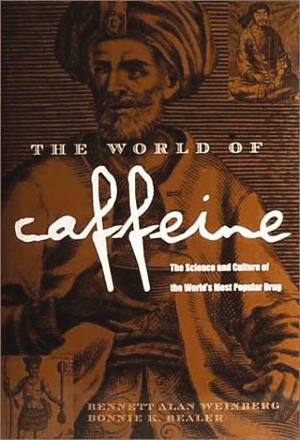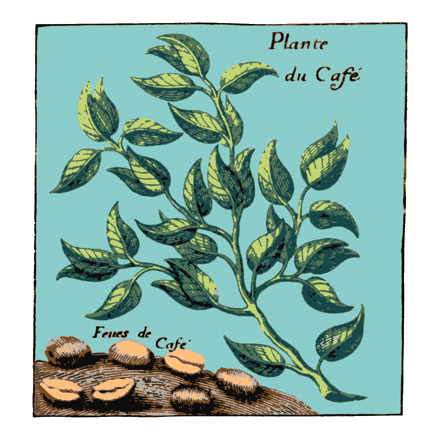Dancing Goats, Coffee Houses, and the Chic of Araby

The World of Caffeine might seem an ambitious title, but there is very little information about caffeine—from the historical to the pharmacological—that is missing from this comprehensive tome. In fact, this book is chock-full of more facts on caffeine, coffee, tea, cocoa and related beverages than one could ever assimilate. Within each of the book’s five parts—Caffeine in History; Europe Wakes up to Caffeine; The Culture of Caffeine; The Natural History of Caffeine; and Caffeine and Health—the authors generally treat coffee and tea in separate chapters. Although also addressed by Weinberg and Bennett, cacao, mate, and related caffeine-containing substances receive much less attention.
Coffee, tea, and cocoa were enjoyed as beverages as early as the sixteenth and seventeenth centuries, although in their early history they were appreciated not for their social value but for their medicinal and physiological properties. However, caffeine as a discrete entity was not discovered until the beginning of the nineteenth century. The poet Goethe gave Friedlieb Runge, who later became well known for synthesizing brightly colored dyes from coal tar (cf. Beyond the Bench, Molecular Interventions, June 2002), a sample of Arabian mocha beans. Runge was able to analyze the beans, and by utilizing a number of chemical extractions, he was able to partially purify caffeine and a few other constituents of the beans.

Despite their histories being unconnected, there are significant parallels in the history of tea and coffee. Both are harvested as a wild leaf or berry and were used medicinally. Both have been cultivated as a social beverage only in their recent history. Each was brought to the regions that are today associated with their origins by religious devotees who initially used them to stay awake during their meditations. Early in their history, the Chinese tried to keep the cultivation of tea to themselves, just as the Arabs did for coffee. And once export did begin, both products were the subject of trade monopolies by a single nation. Both compounds have been associated with political unrest, or at least with the perception of political unrest by the rich and powerful, such that tea houses and coffee houses went in and out of favor wherever they sprang up around the world. Additionally, from their first appearance, tea leaves were used as a medium of exchange in China, coffee beans in Arabia, cola nuts in Africa, and cacao pods in the Americas.
“Everybody is using coffee. If possible, this must be prevented. My people must drink beer.”
—Frederick the Great
The authors discuss the coffee houses of England in great depth. There is even an appendix that goes further into detail about them. By 1700, Weinberg and Bennett estimate that London had one coffee house for every 1000 people, or nearly forty times the number of coffee houses in New York City today. The prestigious Royal Society started out in 1655 as the Oxford Coffee Club: an informal group (or “confraternity” as the authors refer to it) of scientists and students who convened at the house of Arthur Tillyard, an apothecary who prepared and sold coffee, to drink his brew and engage in lively discussion. The taste of coffee at this point was bitter and rather unpleasant, so it is clear that the club members drank it for its stimulant properties. Sometime before 1662, the Oxford Coffee Club moved its coffee klatch to London and in 1663, the club was granted a charter by Charles II as the Royal Society of London for the Improvement of Natural Knowledge. (Sometime in the last 340 years, they lost the last part of their name.)
“Tea makes me think of hay and dung, coffee of soot and lupine-seed, and chocolate is too sweet for me—it gives me a stomachache...”
—Charlotte Elizabeth
Similarly, White’s Club on St. James Street, famous as the men’s club where the most fashionable of English aristocracy gathered in the 1700s, started life as Francis White’s Chocolate House. Although we tend to associate Britons with tea, tea was not actually popular in England until 1662, following the marriage of Charles II to Catherine of Braganza (Portugal). Among her dowry were a large chest filled with tea and the title to the colony of Bombay. Tea became the rage at court, and The British East India Company was born.
Among the other tidbits in this book that collectors of trivia will enjoy are: the linguistic origins of “coffee,” “tea,” and “cocoa”; the role of cocoa in poisoning unpopular persons in early Spain—cocoa masked the taste of poisons; the invention of the teabag; the modest origins of the Melitta brewing company; the medical arguments about coffee and tea over the ages, including one prominent physician’s recommendation that one should drink 200 cups daily; the relationship between Coca-Cola and Santa Claus; and the cultivational needs of the two primary kinds of coffee: robusta and arabica.
I found the least interesting part of the book to be the part on caffeine and health. That is partly because this is the aspect with which I am most familiar, but also because there is a great deal of ambiguity in the research concerning caffeine’s effects on various physiological functions. Also, although the authors are quite good at presenting historical and objective accounts (and have a flair for excellent writing), they are less adept at interpreting scientific results; however, this might be because they attempt to present all effects ascribed to caffeine (whether real or not) and the robust and bogus theories that abound about caffeine.
This is not a book that one can sit down and read straight through—there are too many facts for that—nonetheless, the authors have put together an eminently readable book about caffeine that one can enjoy without needing a cuppa.

- © American Society for Pharmacology and Experimental Theraputics 2003



